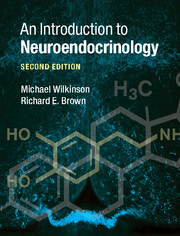Book contents
- Frontmatter
- Dedication
- Contents
- Preface to the second edition
- Acknowledgements
- List of abbreviations
- 1 Classification of chemical messengers
- 2 The endocrine glands and their hormones
- 3 The pituitary gland and its hormones
- 4 The hypothalamic hormones
- 5 Neurotransmitters
- 6 Neurotransmitter and neuropeptide control of hypothalamic, pituitary and other hormones
- 7 Regulation of hormone synthesis, storage, release, transport and deactivation
- 8 Regulation of hormone levels in the bloodstream
- 9 Steroid and thyroid hormone receptors
- 10 Receptors for peptide hormones, neuropeptides and neurotransmitters
- 11 Neuropeptides I: classification, synthesis and co-localization with classical neurotransmitters
- 12 Neuropeptides II: function
- 13 Cytokines and the interaction between the neuroendocrine and immune systems
- 14 Methods for the study of behavioral neuroendocrinology
- 15 An overview of behavioral neuroendocrinology: present, past and future
- Index
- References
3 - The pituitary gland and its hormones
Published online by Cambridge University Press: 05 June 2015
- Frontmatter
- Dedication
- Contents
- Preface to the second edition
- Acknowledgements
- List of abbreviations
- 1 Classification of chemical messengers
- 2 The endocrine glands and their hormones
- 3 The pituitary gland and its hormones
- 4 The hypothalamic hormones
- 5 Neurotransmitters
- 6 Neurotransmitter and neuropeptide control of hypothalamic, pituitary and other hormones
- 7 Regulation of hormone synthesis, storage, release, transport and deactivation
- 8 Regulation of hormone levels in the bloodstream
- 9 Steroid and thyroid hormone receptors
- 10 Receptors for peptide hormones, neuropeptides and neurotransmitters
- 11 Neuropeptides I: classification, synthesis and co-localization with classical neurotransmitters
- 12 Neuropeptides II: function
- 13 Cytokines and the interaction between the neuroendocrine and immune systems
- 14 Methods for the study of behavioral neuroendocrinology
- 15 An overview of behavioral neuroendocrinology: present, past and future
- Index
- References
Summary
The pituitary gland
The pituitary gland, which is also called the hypophysis, is attached to the hypothalamus at the base of the brain (Figure 3.1). Secretion of the hormones of the pituitary gland is regulated by the hypothalamus and it is through the hypothalamic-pituitary connection that external and internal stimuli can influence the release of the pituitary hormones, thus producing the neural-endocrine interaction. The pituitary has been called the body's “master gland” because its hormonal secretions stimulate a variety of endocrine glands to synthesize and secrete their own hormones. However, it is really the hypothalamus that is the master gland, because it controls the pituitary.
The pituitary gland consists of two primary organs: the anterior pituitary (adenohypophysis or pars distalis) which is a true endocrine gland, and the posterior pituitary (neurohypophysis) which is formed from neural tissue and is an extension of the hypothalamus (Figure 3.1). The pituitary gland is attached to the hypothalamus by the pituitary (hypophyseal) stalk. Further details of the anatomy and physiology of the pituitary gland can be found elsewhere (Norman and Litwack 1997; Amar and Weiss 2003; Boron and Boulpaep 2005; Gardner and Shoback 2011).
The neurohypophysis (posterior pituitary)
The neurohypophysis consists of neural tissue and contains the nerve terminals (about 100,000) of axons whose cell bodies are located in the paraventricular nucleus (PVN) and supraoptic nucleus (SON) of the hypothalamus. The axons of these large magnocellular neurosecretory cells project down from the hypothalamus through the part of the pituitary stalk called the infundibulum and terminate in the posterior pituitary gland (Figure 3.2). The neurosecretory cells of the PVN and SON manufacture the hormones oxytocin and vasopressin (also called antidiuretic hormone, ADH), which are transported down the axons and stored in nerve terminals in the posterior pituitary. The axon terminals in the posterior pituitary are surrounded by supporting cells called pituicytes.
- Type
- Chapter
- Information
- An Introduction to Neuroendocrinology , pp. 45 - 56Publisher: Cambridge University PressPrint publication year: 2015
References
- 1
- Cited by

